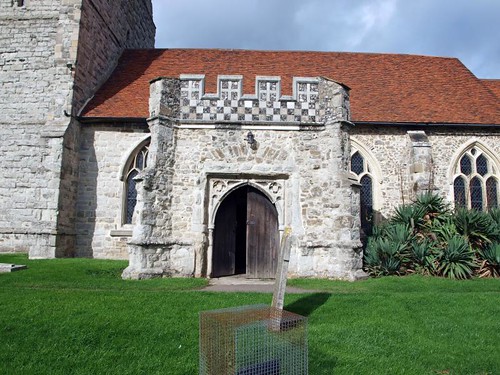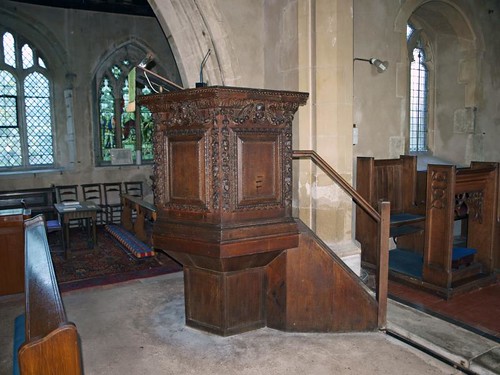ST NICHOLAS. Considering the part of Essex where it stands, an unusually stately church. Big massive and tall W tower of elephant-grey dressed ragstone. Built in four stages with angle buttresses and battlements with stone and flint chequer. W doorway with decorated spandrels. Three-light W window and to its l. and r. two shields. Also recesses l. and r. of the doorway and in the W faces of the buttresses. All this must be C15. Of the same time the S front of the nave and broad three-light windows with coarse panel tracery, and the S porch with battlements of stone and flint chequer, an outer and an inner doorway with shields in the spandrels and two-light N and S windows. The rest is mostly C14, see the three-light intersected tracery in a N aisle window and the W bays of the N arcade with octagonal piers and hood-moulds on defaced corbels. The E pier is late C15. Nave roof with tiebeams, king-posts and four-way struts. - PULPIT. Can it have been made for the village? It might come from any prosperous town church of the Restoration period. Panels with garlands and cherubs’ heads. - PLATE. Cup of 1665.
CANEWDON. We may still trace the entrenchments, beyond the peaceful cottages, which remind us that hereabouts was fought one of the battles which changed our history and established on the throne our Danish king. Here it was that Canute, in the crisis of his fate, encamped his army before his last great fight with his pursuing adversary, Edmund Ironside. The English king, elated by his victories at Offord in Kent and elsewhere, pressed on determined to thrust the Dane out of the realm, but it was Canute who won the day.
The Roman bricks at the foot of the wall of this church were probably laid by men who saw that famous fight, and the village is believed to have been named after the victor. With the Normans came prosperity. There were six lords of manors here and the great size of the church bears witness to the needs of the 14th century, when the chancel, nave, and aisle were rebuilt. The tower is the chief glory of the building, with walls seven feet thick and rising 75 feet, dwarfing the huge elms. Three shields above the door tell something of our story: the middle shield shows the arms of France and England in the time of Henry the Fifth, and another the arms of the Bohuns. Mary de Bohun was the mother of the king, and it is said that Henry built this tower as a thankoffering for Agincourt. We ascend a hundred winding stairs and a hundred square miles of Essex lie spread before us, the little white yachts off Burnham gleaming in the sunlight, and on the horizon ships edging their way round Maplin Sands into the Thames, while the blue hills of Kent leap up to meet the southern sky. Small wonder that over 400 years ago they chose this tower as a beacon for ships at sea.
There are many treasures in the church over which to linger in admiration, and the wide 15th century windows give ample light. In the chancel wall are preserved painted shafts and painted niches, red and green and gold. Broken in two, a great altar stone rests on the floor of an aisle, four of its consecration crosses still visible. The 14th century arches of the nave rest on carvings in stone; we noticed the head of a woman, a bird, and a beast, and the shield of a family which came over with the Conqueror. The church has a wealth of woodwork. The roof of the nave has bold kingpost trusses that have lasted 500 years. A small ironbound box with strap-hinges was perhaps the money box from which the builders were handed their wages. There is one of the quaintest of old money boxes, its lid with a curiously hollowed surface.
Here, too, are interesting possessions in wood brought from London after the Great Fire. One is an organ rescued from a chapel of old St Paul’s; Milton himself may have pressed its keys. Another is a magnificent pulpit from a City church, with cherubs, foliage, and fruit in its panels which may very well have been carved in the workshop of Grinling Gibbons.
Flickr.



No comments:
Post a Comment